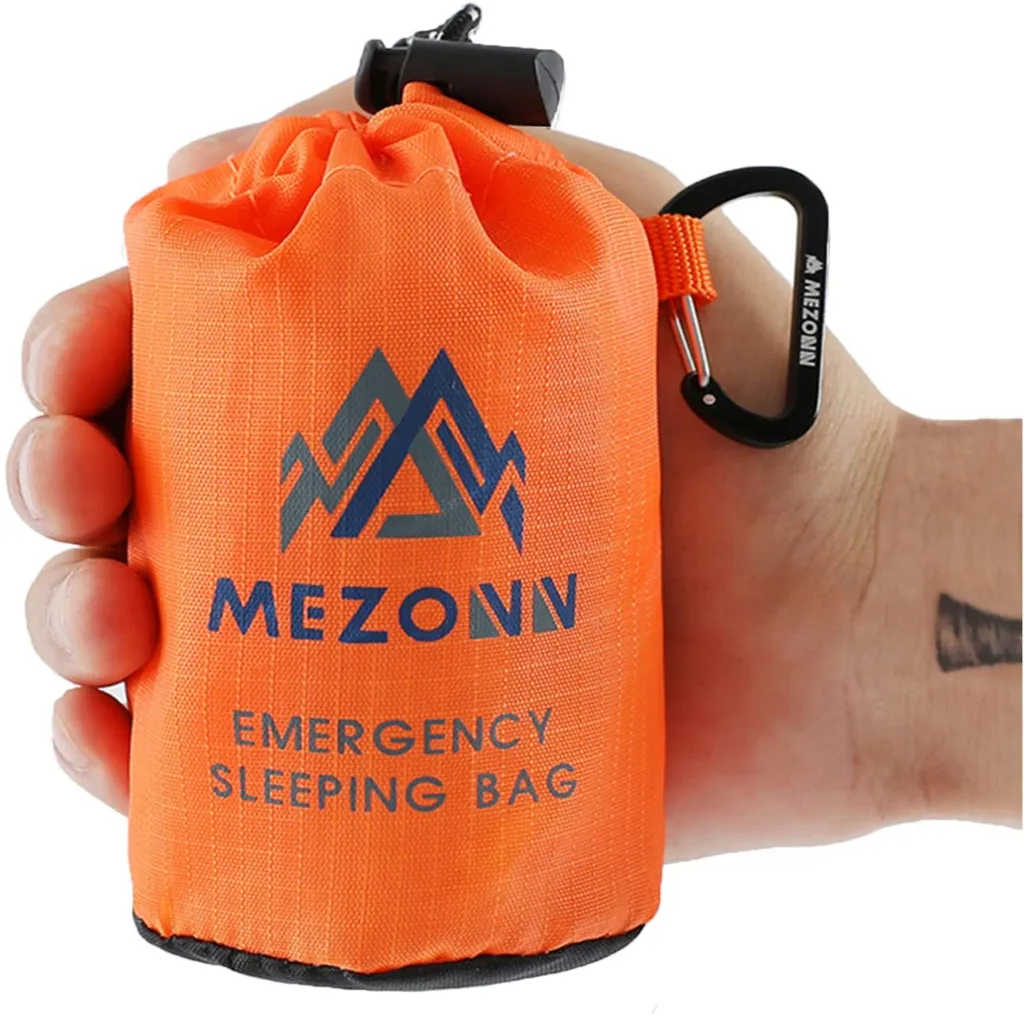Emergency Sleeping Bag: The 5 Ultimate Survival Gear
Table of Contents

Introduction
Having the appropriate equipment is crucial for outdoor excursions, camping, and emergency situations. The Emergency Sleeping Bag is an example of a piece of equipment that can save your life in an emergency. A survival pack must include an emergency sleeping bag because it is made to offer warmth, security, and comfort. We will examine the characteristics, advantages, and ideal methods for using an emergency sleeping bag in this in-depth article.
What is an Emergency Sleeping Bag?
A small, light-weight sleeping bag made expressly for emergencies is called an emergency sleeping bag. Its construction uses strong, weather-resistant materials that can tolerate extreme temperatures. As opposed to ordinary sleeping bags, emergency sleeping bags offer insulation to hold onto body heat, keeping the user warm even in extremely cold weather.
Why Do You Need an Emergency Sleeping Bag?
Having an emergency sleeping bag might make a life or death difference in dire circumstances. You should include an emergency sleeping bag in your survival kit for the following reasons:
- Protection from the Elements: A sleeping bag for emergencies serves as a shield between you and the corrosive outdoor elements. It protects you from the cold, wind, and wetness by acting as insulation, keeping you warm and dry.
- Versatility: Emergency sleeping bags are quite adaptable and can be utilised in a variety of circumstances. An emergency sleeping bag is a trusty ally whether you’re trapped in the outdoors, dealing with a natural disaster, or just camping in erratic weather.
- Compact and Lightweight: Compact and Lightweight: Emergency sleeping bags are made to be smaller and lighter than regular sleeping bags. They are perfect for emergency preparedness kits and trekking because they are simple to fold and store in a compact area.
- Emergency Preparedness: Emergency Planning: Access to shelter may be restricted during emergencies like earthquakes, hurricanes, or other natural catastrophes. In the interim, an emergency sleeping bag offers a comfortable way to wait for assistance.
- Peace of Mind: Having a dependable emergency sleeping bag on hand during outdoor excursions or emergency scenarios gives you peace of mind. You may concentrate on other important things without being concerned about your security and well-being.

Key Features of an Emergency Sleeping Bag
Several important characteristics should be taken into account while selecting an emergency sleeping bag. The following are the key characteristics to consider:
Compact and Lightweight Design
For ease of portability, an emergency sleeping bag should be small and light. In order to fit it into your backpack or emergency kit without adding more weight, look for models that can be compacted into a small carrying bag.
Durable and Weather-Resistant Materials
It is essential to select a sleeping bag made from strong, weather-resistant materials because emergency sleeping bags are built for extreme situations. Look for materials that can survive rough use and offer defence against water and wind, such as ripstop nylon or polyester.
Reflective Exterior
A reflective exterior is common on emergency sleeping bags, which improves visibility while it’s dark outside. This can help you stand out during rescue operations, which will make it simpler for search crews to find you.
Insulation and Heat Retention
When it comes to emergency sleeping bags, insulation is a key component. Look for bags that can keep you warm even in subfreezing situations and have strong heat retention capabilities. Some bags improve heat retention by using specialised materials like Mylar.
Breathability and Moisture Management
While being warm is crucial, breathability and moisture management are as important. To ensure comfort during the night, look for bags with ventilation characteristics that reduce excessive perspiration and moisture build-up inside the bag.
Size and Ergonomics
To guarantee a comfortable fit, think about the emergency sleeping bag’s size and ergonomics. You should look for bags that provide you adequate space to move around comfortably. To fit a range of body types, certain bags are available in several sizes.
Easy Deployment and Packing
Time is of the importance when there is an emergency. Select a sleeping bag for emergencies that you can use and store quickly. For simple setup and storage, look for models with features like quick-release buckles or drawstring closures.
Multi-Functional Design
Some survival sleeping bags come with extra components that improve their functionality. These might have built-in hoods, ventilation zippers, or even the capacity to transform into a temporary shelter. Consider your unique requirements and pick a bag that delivers the appropriate features.

How to Use an Emergency Sleeping Bag?
The most effective use of an emergency sleeping bag will assure your safety and comfort. An instruction manual for using an emergency sleeping bag is provided below:
- Choose an Appropriate site: Choose a site that offers protection from the weather, such as high winds or heavy rain. Remove any sharp objects or debris that could hurt the sleeping bag from the vicinity.
- Prepare the Sleeping Bag:Remove the emergency sleeping bag from its carrying case or storage bag to prepare it. It should be unfolded and gently shaken to fully expand. Before usage, check for any rips or damages.
- Enter the Sleeping Bag: Putting on the sleeping bag Slide inside the sleeping bag after carefully opening it. If the bag has a built-in hood, make sure your head is in the appropriate spot. Aligning yourself with the bag’s opening will help.
- Seal the Opening: To seal the sleeping bag’s opening, pull it tightly around your face and neck. By doing so, you’ll be able to keep your body warm and keep cold air out. If available, use the drawstring or Velcro closures.
- Position Yourself: Position yourself to be as comfortable as possible inside the sleeping bag. Align yourself with the contour of the bag by spreading your arms and legs straight. The insulation shouldn’t be compressed because doing so can make it less effective.
- Stay Dry and Warm: If the ground is wet, put a groundsheet or another layer underneath you to stop moisture from absorbing through the surface. To increase warmth, fill in any spaces between your body and the sleeping bag with extra clothing or blankets.
- Ventilate if Necessary: If you begin to feel overheated or perspire while inside the bag, unzip the zipper a little or, if provided, use the ventilation systems to allow air to circulate. Track your comfort level and make necessary adjustments.
- Be Aware and Prepared: Even while you’re in your sleeping bag, keep an eye out for any potential hazards. In case of crises, keep necessary materials close at hand, such as a whistle, torch, or communication device.

FAQs about Emergency Sleeping Bags.
Q: How is an emergency sleeping bag different from a regular sleeping bag?
- Emergency sleeping bags are made with compactness, lightweight, and insulation for survival scenarios in mind rather than long-term use and comfort. They are made primarily to offer vital warmth and safety in situations.
Q: Are emergency sleeping bags reusable?
- Emergency sleeping bags are often made to be used only once or occasionally. Even if some bags might be washable and reusable, it’s best to change them after each use or as directed by the manufacturer. It is essential to regularly check for damage to ensure their efficiency.
Q: Can I use an emergency sleeping bag in extreme temperatures?
- Emergency sleeping bags are made with insulation and heat retention in mind. Extreme temperatures, however, may affect how effective they are. It is crucial to examine the manufacturer’s temperature rating and pick a sleeping bag appropriate for the predicted weather.
Q: Are emergency sleeping bags waterproof?
- Even though they are frequently composed of weather-resistant fabrics, emergency sleeping bags could not be totally waterproof. They can offer defence against moisture or light rain, but their effectiveness may be compromised by extended exposure to heavy rain or submersion in water. If necessary, it is advised to take additional waterproofing precautions.
Q: Can an emergency sleeping bag be used as a shelter?
- Some emergency sleeping bags include a multipurpose design that enables them to be used as a temporary shelter. For this reason, they might have additional apertures, attachment points, or reinforced corners. It’s crucial to keep in mind, though, that a sleeping bag’s main purpose is to offer insulation and warmth.
Q: How should I store an emergency sleeping bag?
- Make sure the emergency sleeping bag is dry and clean after usage. Return it to its original carrying case or storage bag after neatly folding it. Keep it away from strong sunlight and severe temperatures in a cool, dry place. Check regularly for any indications of wear or damage, and replace as necessary.




